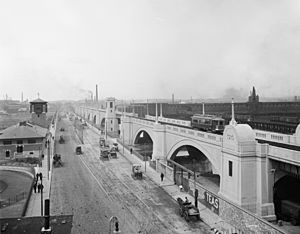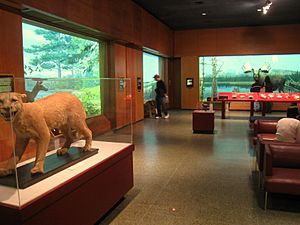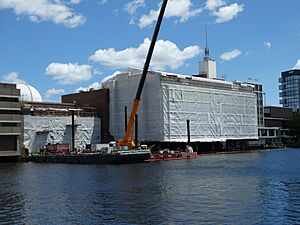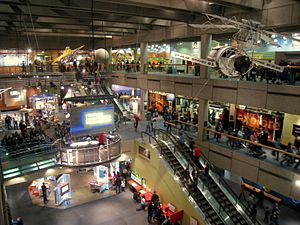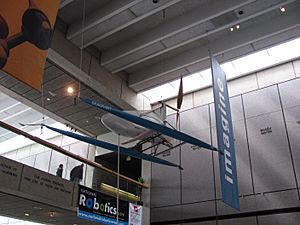Museum of Science (Boston) facts for kids
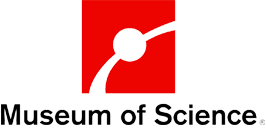 |
|
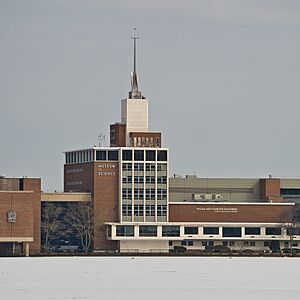
View from Cambridge; the central Yawkey Gallery on the Charles River overlooks the river basin in the foreground
|
|
| Established | 1830 |
|---|---|
| Location | Boston, Massachusetts |
| Type | Science museum Indoor zoo |
| Accreditation | AAM, ASTC, AZA |
| Visitors | 1.53 million (2016) |
| Public transit access |
Green Line
Science Park station |
| Nearest parking | Dedicated parking garage (fee) |
The Museum of Science (MoS) is a cool place in Boston, Massachusetts. It's a science museum and also has an indoor zoo! You can find it in Science Park, which is a special area that stretches across the Charles River.
The museum has over 700 hands-on exhibits. This means you can touch and interact with many displays. Every day, there are live shows and presentations. You can also watch amazing films at the Charles Hayden Planetarium and the Mugar Omni Theater. The Omni Theater is New England's only domed IMAX theater, which makes movies feel super real!
The Museum of Science is part of important groups like the Association of Science and Technology Centers (ASTC) and the American Alliance of Museums (AAM). It's also approved by the Association of Zoos and Aquariums (AZA) because it cares for over 100 animals.
Contents
The Museum's Story: How It Began
Starting Small: The Early Years
The museum started way back in 1830. It was first called the Boston Society of Natural History. A group of men who loved science created it. Their first meeting was on February 9, 1830, with seven original members. In the 1800s, people often called it the Boston Museum of Natural History.
In 1862, the society built a new home in the Back Bay area of Boston. They named it the New England Museum of Natural History. This building was next to the Massachusetts Institute of Technology (MIT). Both buildings were designed by William G. Preston. The original MIT building was taken down in 1939. But the Natural History Museum building is still there today, used for home furnishings.
The society did a lot of science work, especially about rocks and the Earth. They published their findings in a book called Proceedings of the Boston Society of Natural History. Around 1900, they added a library and special rooms for children. In 1939, the museum changed its name to the Museum of Science. This happened under the leadership of Henry Bradford Washburn, Jr., a famous American mountain climber.
Moving to a New Home After WWII
After World War II, the old Museum of Science building was sold. The museum moved to a new spot and was called the Boston Museum of Science again. Bradford Washburn helped the museum get a special deal. They leased land on the Charles River Dam Bridge for 99 years for just $1 a year! This area is now called Science Park. Building started in 1948, and the museum opened in 1951. It was one of the first museums in the country to cover all areas of science.
In these early years, the museum created a traveling planetarium. A version of this still visits many elementary schools in the Greater Boston area. They also got a great horned owl named "Spooky." He became a symbol of the museum and lived to be 38, which is very old for an owl! Today, you can still see many stuffed animals on display. They teach kids about animals from New England and around the world.
The Science Park train station opened in August 1955. This made it much easier for people to visit the museum by public transport. In 1955, MIT gave the museum its Round Hill generator. This became the main attraction of the Theater of Electricity. The Charles Hayden Planetarium, a permanent building, opened in 1958.
The museum kept growing in the 1970s and 1980s. In 1999, The Computer Museum in Boston closed. Some of its educational displays moved to the Museum of Science. Most of the old computer items went to the Computer History Museum in California.
The Museum in the 21st Century
The museum had a big makeover and expansion in 2005 and 2006. In 2010, the Charles Hayden Planetarium closed for updates and then reopened.
The main entrance of the museum is right on the line between Boston and Cambridge. A special marker on the floor inside shows this boundary. In 2013, the museum hosted the first joint meeting of the Boston and Cambridge city councils. They talked about how to keep talented university graduates in the area.
Starting in 2013, the Museum of Science began a huge renovation project. They wanted to update the building and create new exhibits. A $250 million project updated almost half of the exhibit halls. Three new major exhibits opened: the Hall of Human Life, the Yawkey Gallery on the Charles River, and What Is Technology?. The Hall of Human Life opened in November 2013. It focuses on how the human body works. The cool rolling ball sculpture Archimedean Excogitation moved to the atrium. This made space for the new Yawkey Gallery on the Charles River. This gallery opened in 2016. It created a new entrance with great views of the Charles River and the Boston-Cambridge skyline.
On October 18, 2016, Michael Bloomberg, a former mayor of New York City, announced a huge gift. His foundation, Bloomberg Philanthropies, donated $50 million to the museum. This was the biggest gift in the museum's history! He grew up nearby, and his donation helps expand the museum's educational programs.
In 2024, the museum started building a Public Science Common. This new, flexible meeting space will have glass walls. It replaces an older, windowless area. This new space will be a central spot for three learning centers: the Center for Life Sciences, the Center for the Environment, and the Center for Space Sciences. This project is planned to finish in 2026.
Future Plans: A Special Memorial
A memorial to Leonard Nimoy is planned for the area in front of the museum. He was a famous actor who grew up nearby in Boston. The sculpture will be a large, 20-foot-tall hand showing Nimoy's famous "live long and prosper" gesture. Nimoy's family is helping with the project. As of November 2024, most of the money for it has been raised.
Explore the Exhibits: What to See
Blue Wing: Science in Action
- Theater of Electricity: This show features the Round Hill generator. It's the world's largest air-insulated Van de Graaff generator! The show also includes demonstrations with Tesla coils and other cool electrical machines.
- Seeing is Deceiving: A fun collection of optical illusions, including many that move.
- Arctic Adventure: Exploring with Technology
- Exploring with AI: Making the Invisible Visible
- Giant Sequoia Tree
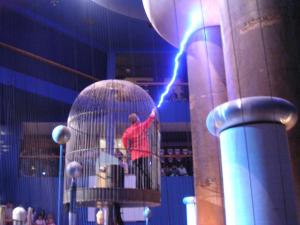
- Mathematica: A World of Numbers... and Beyond: A room full of classic moving and still math exhibits. These were designed by Charles and Ray Eames.
- Natural Mysteries: An exhibit where you investigate and classify mysterious objects and natural history items.
- Math Moves!: Experiencing Ratio and Proportion: An immersive exhibit about math and how things relate in size.
- Clark Collection of Mechanical Movements: This collection has over 100 working models of mechanical motions and linkages. As of 2024, parts of it are in the Theater of Electricity and the Engineering Design Workshop.
- Faces of Science: Ambassadors for Equity: Learn how professionals use their life experiences in their jobs.
- Natural Beauty: The Harold Grinspoon Collection
- Science in the Park: A playground on Level 2 of the Blue Wing. It uses everyday objects to explore science.
- Nanotechnology
- Take a Closer Look
- Dinosaurs: Modeling the Mesozoic: A collection of fossils and life-size models of dinosaurs. This includes a full-size Tyrannosaurus rex!
- Colossal Fossil: Triceratops Cliff: See a 65-million-year-old fossil found in 2004.
- Machines & Transportation
- To the Moon
- Engineering Design Workshop: A place to design, build, and test solutions to problems. As of 2024, this is on Level 1 of the Blue Wing.
- Temporary exhibits: As of early 2024, these include Innovation: Earth and a Sustainable Farm.
Green Wing: Life and Nature
- New England Habitats: Life-sized dioramas showing typical New England environments and animals.
- A Bird's World
- Colby Room: A classic explorer's room with stuffed animal heads. It's kept as a historical exhibit and used for meetings.
- Hall of Human Life: An exhibit with interactive activities focusing on human biology.
- Rotating temporary exhibits: From November to January, this usually includes an exhibit about trains called All Aboard! Trains at Science Park.
Red Wing: Space and Wonders
- Mugar Omni Theater: The largest Omnimax movie theater in New England.
- Charles Hayden Planetarium
- Cosmic Light: A small space exhibit in the planetarium waiting area. It shows real images of space and small bronze models of the Sun and planets.
- Foucault pendulum: This shows how the Earth rotates.
- Polage: A wall-sized art piece made of shapes using polarized light by artist Austine Wood Comarow.
- Soundstair: A stairway created by artist Christopher Janney. It uses light sensors to make musical sounds when you walk on it.
- Archimedean Excogitation: A large rolling ball sculpture by George Rhoads.
- Museum Store
Other Cool Spots
- Yawkey Gallery on the Charles River: An open area at the back of the entrance hall. It has lots of information about the Charles River and river science.
- The Rock Garden: An outdoor area in front of the museum. It shows large mineral specimens with signs explaining where they came from.
- Five decorative aluminum panels used to be on the museum's outside wall facing the Charles River. They were made by sculptor Theodore Barbarossa. These panels were removed for the new glass-enclosed Public Science Common. Their future location is not yet known.

Past Exhibits: A Look Back
- In the 1950s, a small Wilson cloud chamber was in the main entrance. Visitors could get close to radioactive material and see the trails of particles.
- The first Fresnel lens in the US that used electricity was on display from the early 1950s until 1979. It came from the Navesink lighthouse.
- From 1969 to 1985, the museum displayed a steam locomotive, Boston and Maine 3713. It was outside the museum building.
- In 1988, the museum hosted an exhibit about the life of Ramses II. It showed over 70 items from the Egyptian Museum in Cairo. A main part of the exhibit was a 40-foot-tall model of an Egyptian temple. It held a 3,000-year-old, 57-ton granite statue of Ramses.
- From August to October 2004, the museum hosted the US premiere of The Lord of the Rings the Motion Picture Trilogy the Exhibition. This exhibit had many costumes and props from the famous films.
- The Museum of Science created its own film-based exhibit called Star Wars: Where Science Meets Imagination. It was on display there from October 2005 to April 2006.
- Gunther von Hagens' Body Worlds 2: The Anatomical Exhibition of Real Human Bodies was at the Museum of Science from July 29, 2006, to January 7, 2007.
- Harry Potter: The Exhibition was at the museum from October 25, 2009, to February 21, 2010.
- The Science Behind Pixar is a 13,000 square foot exhibit. It was created by the Museum of Science with Pixar Animation Studios. This exhibit showed how math, computer science, and physical science are used to make animated films.
Computing and Technology Exhibits
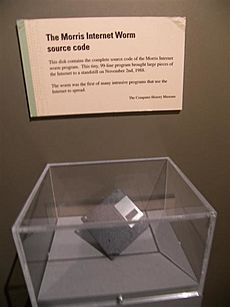
When The Computer Museum closed, some of its educational exhibits moved to the Boston Museum of Science. Two new computing and technology exhibits were created. The Computing Revolution exhibit, which is no longer on display, told the history of computing. Cahners ComputerPlace used to have displays from educational video games to an interactive AIBO ERS-7 robot. The first integrated quantum computing system, created with IBM, is on display as part of the museum's computing exhibits.
More to See and Do
- In 1997, the museum created a permanent, to-scale Solar System model. It stretched as far as the Riverside MBTA station. This model was featured in the PBS Kids show FETCH! with Ruff Ruffman. In the show, kids went on a scavenger hunt to find all the bronze model planets. The models of the Sun, Mercury, and Venus were on the museum grounds. However, in 2015, some models were moved. As of 2023, only the model of Mars remained inside Cambridgeside Galleria Mall.
- Construction began on a rooftop Wind Turbine Lab in 2009. This lab tests nine wind turbines from five different companies on the museum's roof. An exhibit in the Blue Wing, Catching the Wind, shows live data on how much electricity each turbine produces.


